Do you feel stressed, anxious, or out of balance in your life? Do you want to learn how to tap into your inner energy and heal yourself from within? If so, you might benefit from learning about the chakra symbols and how they can help you achieve a state of harmony and well-being.
Chakras are the energy centers of the body, located along the spine from the base to the crown of the head. Each chakra corresponds to a different aspect of your physical, mental, emotional, and spiritual health. When your chakras are aligned and balanced, you feel happy, healthy, and fulfilled. But when they are blocked or imbalanced, you may experience various problems such as pain, illness, mood swings, or lack of motivation.
The chakra symbols are ancient symbols that represent the essence and function of each chakra. They can help you visualize and connect with your chakras, as well as activate and heal them. By understanding the meaning and symbolism of each chakra symbol, you can use them as tools to enhance your personal growth and wellness.
In this article, we will explore the meaning and significance of each chakra symbol and how to use them to balance and harmonize our lives. We will also discuss the benefits of chakra healing for energy balance and emotional healing.
Exploring the Seven Chakras and their Symbols
Chakras are the energy centers of the body that regulate our physical, mental, and emotional well-being. Each of the seven major chakras has a unique symbol that represents its essence, qualities, and functions.
The body’s chakra system is a complex network, unlike a busy freeway of spiritual energy. It’s like seven main rest stops along this highway, each with its own unique vibe and services.
In holistic health circles, these energetic pit stops are known as chakras. They’re like power hubs located at specific points from your tailbone to just above your head. Each one is tied to different bodily functions and emotional states. And here’s the kicker—they’re not just some mystical idea; they correspond to actual nerve clusters and major organs.
Starting at the lower spine, we kick off with our first chakra—the root—and climb all the way up to our seventh or crown chakra atop our head. These seven focal points form an invisible ladder within us that can influence everything from how grounded we feel to whether we’re channeling cosmic wisdom through our crown.
The Root Chakra Symbol
The root chakra, or Muladhara, is located at the base of the spine and is associated with the element of earth. It is the foundation of our survival, security, and stability.
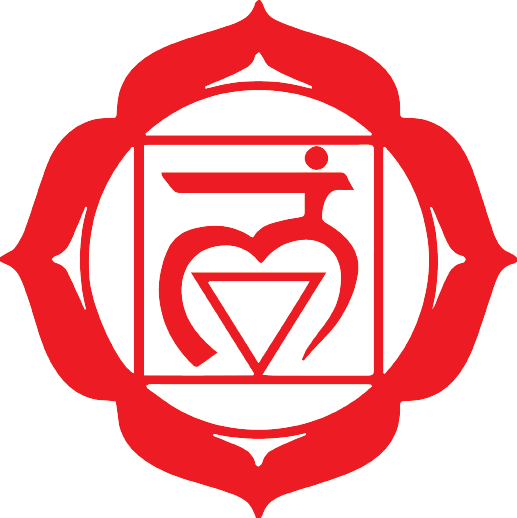
The root chakra symbol is a red square with four petals and a downward-pointing triangle inside. The square represents the solidity and stability of the earth, while the triangle symbolizes the downward flow of energy from the higher chakras to the root.
The four petals correspond to the four aspects of human consciousness: mind, intellect, consciousness, and ego. The root chakra’s seed sound is LAM.
The root chakra is responsible for our sense of security and stability. When it is balanced, we feel grounded, safe, and confident. When it is blocked, we may experience fear, anxiety, insecurity, or lack of trust. Some of the benefits of root chakra healing are:
- Increased energy and vitality
- Reduced stress and anxiety
- Improved immune system function
- Better sleep
The Sacral Chakra Symbol
The sacral chakra, or Svadhishthana, is located just below the navel and is associated with the element of water. It is the center of our creativity, sexuality, emotions, and pleasure.
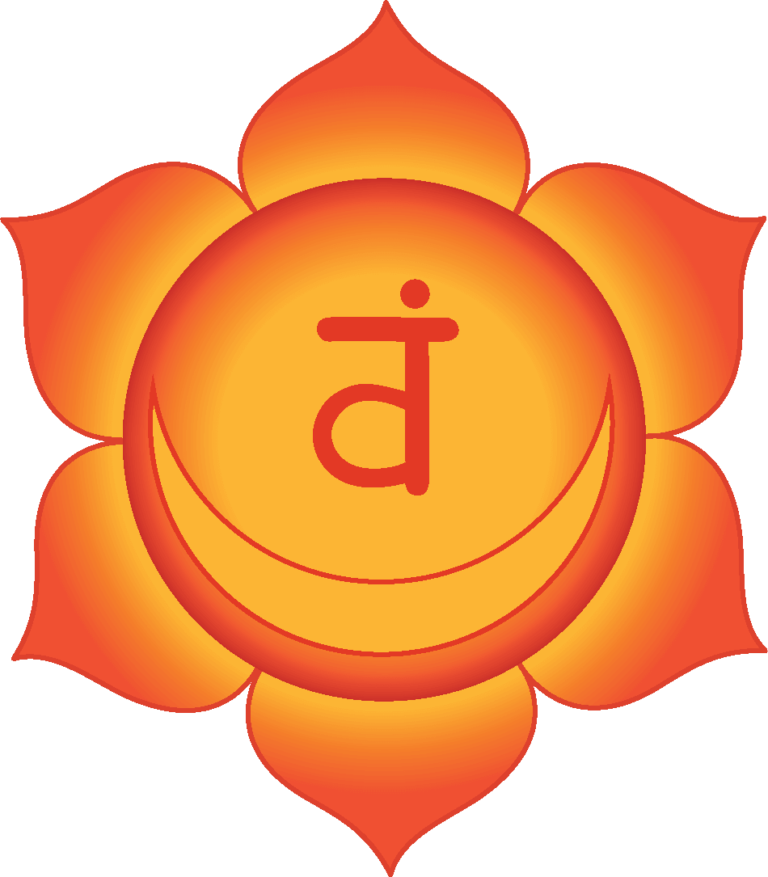
The sacral chakra symbol is an orange circle with six petals and a crescent moon inside. The circle represents the fluidity and movement of water, while the crescent moon symbolizes the feminine energy and cycles of life.
The six petals correspond to the six negative qualities that need to be overcome to balance the sacral chakra: anger, hatred, greed, jealousy, cruelty, and laziness. The sacral chakra’s seed sound is VAM.
The sacral chakra is responsible for our sexual and creative energy. When it is balanced, we feel passionate, joyful, expressive, and adventurous. When it is blocked, we may experience guilt, shame, repression, or emotional instability. Some of the benefits of sacral chakra healing are:
- Increased creativity and intuition
- Greater emotional balance and stability
- Enhanced sexual pleasure and intimacy
- Improved self-esteem and body image
The Solar Plexus Chakra Symbol
The solar plexus chakra, or Manipura, is located above the navel and is associated with the element of fire. It is the center of our personal power, will, confidence, and self-esteem.
The solar plexus chakra symbol is a yellow circle with ten petals and a downward-pointing triangle inside. The triangle and circle represent the radiance and warmth of fire.
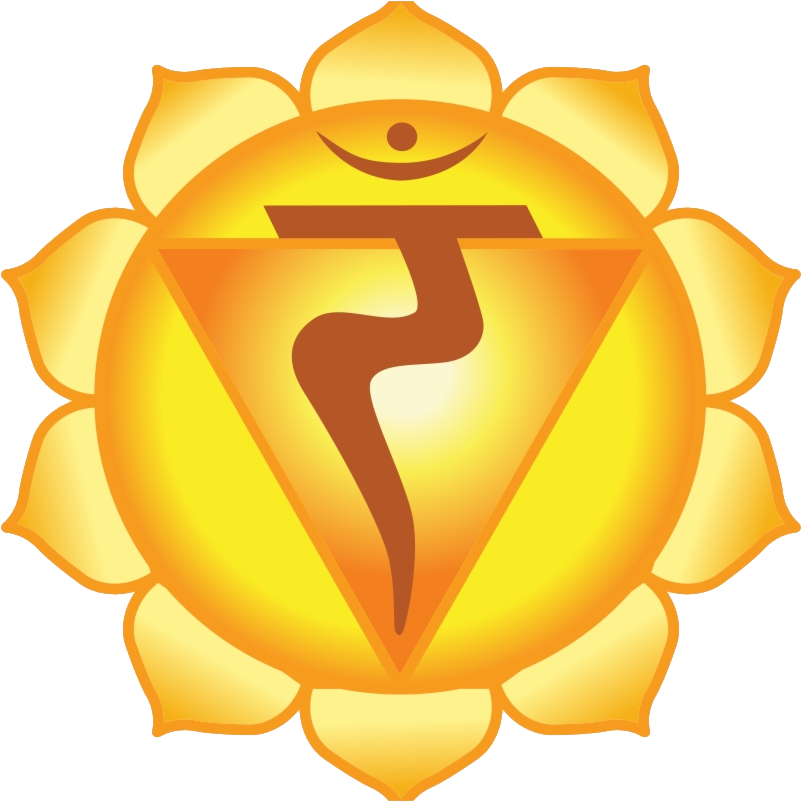
The ten petals correspond to the ten positive qualities that need to be cultivated to balance the solar plexus chakra: spiritual ignorance, thirst, jealousy, treachery, shame, fear, disgust, delusion, foolishness,
and sadness. The solar plexus chakra’s seed sound is RAM रं.
The solar plexus chakra is responsible for our confidence and self-esteem. When it is balanced, we feel empowered, assertive, and decisive. When it is blocked, we may experience doubt, insecurity, or anger.
Some of the benefits of solar plexus chakra healing are:
- Increased confidence and self-esteem
- Reduced stress and anger
- Improved digestion and metabolism
- Enhanced leadership and decision-making skills
The Heart Chakra Symbol
The heart chakra, or Anahata, is located in the center of the chest and is associated with the element of air. It is the center of our love, compassion, empathy, and forgiveness.
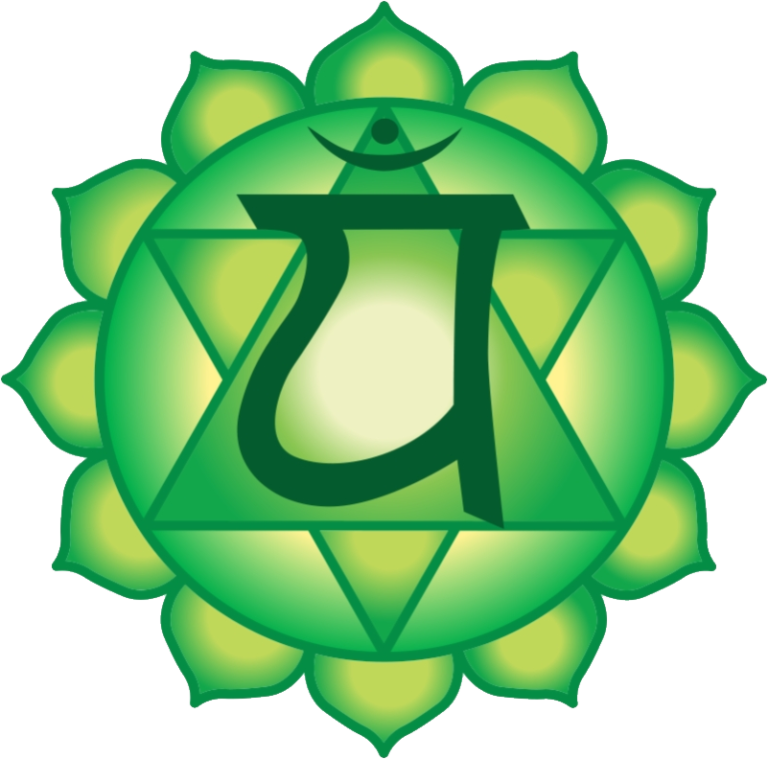
The heart chakra symbol is a green circle with twelve petals and two intersecting triangles inside. The circle represents the expansiveness and freedom of air, while the two triangles symbolize the union
of opposites: male and female, matter and spirit, heaven and earth.
The twelve petals correspond to the twelve virtues that need to be practiced to balance the heart chakra:
bliss, peace, harmony, love, understanding, empathy, clarity, purity, unity, compassion, kindness, and forgiveness. The heart chakra’s seed sound is YAM.
The heart chakra is responsible for our ability to love and show compassion. When it is balanced, we feel loving, compassionate, empathetic, and forgiving. When it is blocked, we may experience grief, resentment, loneliness, or fear. Some of the benefits of heart chakra healing are:
- Increased love and compassion for oneself and others
- Reduced stress and anxiety
- Improved immune system function
- Better sleep
The Throat Chakra Symbol
The throat chakra, or Vishuddha, is located at the center of the throat and is associated with the element of space. It is the center of our communication, expression, and truth.
The throat chakra symbol is a blue circle with sixteen petals and a downward-pointing triangle with a circle inside.
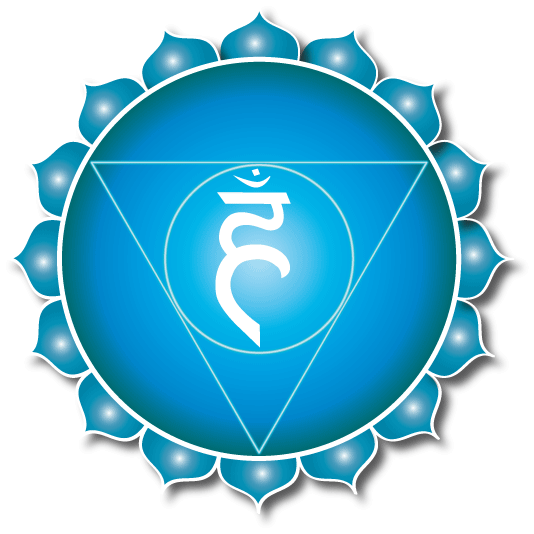
The circle represents the vastness and openness of space, while the triangle symbolizes the downward flow of wisdom from the higher chakras to the throat.
The circle inside the triangle represents the full moon, which signifies the power of speech. The sixteen petals correspond to the sixteen vowels of Sanskrit, which are considered to be pure sounds. The throat chakra’s seed sound is HAM.
The throat chakra is responsible for our ability to communicate verbally. When it is balanced, we feel honest, expressive, and authentic. When it is blocked, we may experience difficulty speaking, listening, or expressing ourselves. Some of the benefits of throat chakra healing are:
- Improved communication and expression
- Enhanced creativity and inspiration
- Increased honesty and authenticity
- Better thyroid health
The Third Eye Chakra Symbol
The third eye chakra, or Ajna, is located between the eyebrows and is associated with light. It is the center of our intuition, imagination, and insight.
The third eye chakra symbol is an indigo circle with two petals and an upward-pointing triangle with an eye inside.
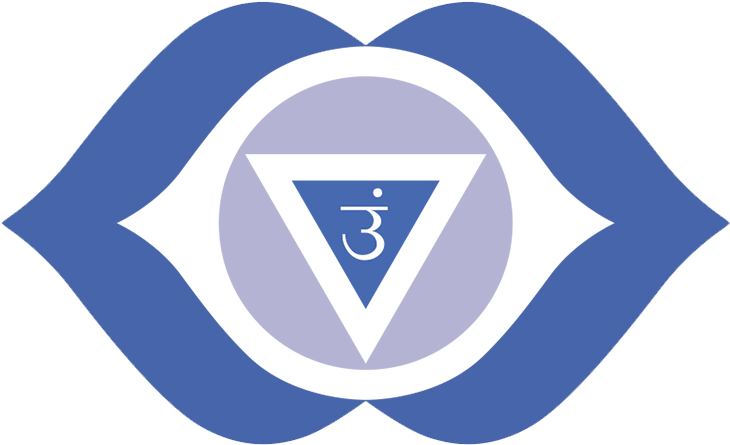
The circle represents the infinite potential of our mind, while the triangle symbolizes the upward flow of energy from the lower chakras to the third eye.
The eye inside the triangle represents the inner vision that sees beyond the physical reality. The two petals correspond to the two aspects of our mind: the rational and the intuitive. The third eye chakra’s seed sound is OM.
The third eye chakra is responsible for our intuition and imagination. When it is balanced, we feel intuitive, imaginative, and insightful. When it is blocked, we may experience confusion, lack of clarity, or detachment from reality. Some of the benefits of third eye chakra healing are:
- Increased intuition and imagination
- Greater clarity and insight
- Enhanced psychic abilities and awareness
- Better vision and perception
The Crown Chakra Symbol
The crown chakra, or Sahasrara, is located at the top of the head and is associated with pure consciousness. It is the center of our spiritual connection, enlightenment, and transcendence.
The crown chakra symbol is a violet circle with a thousand petals and an OM symbol inside.
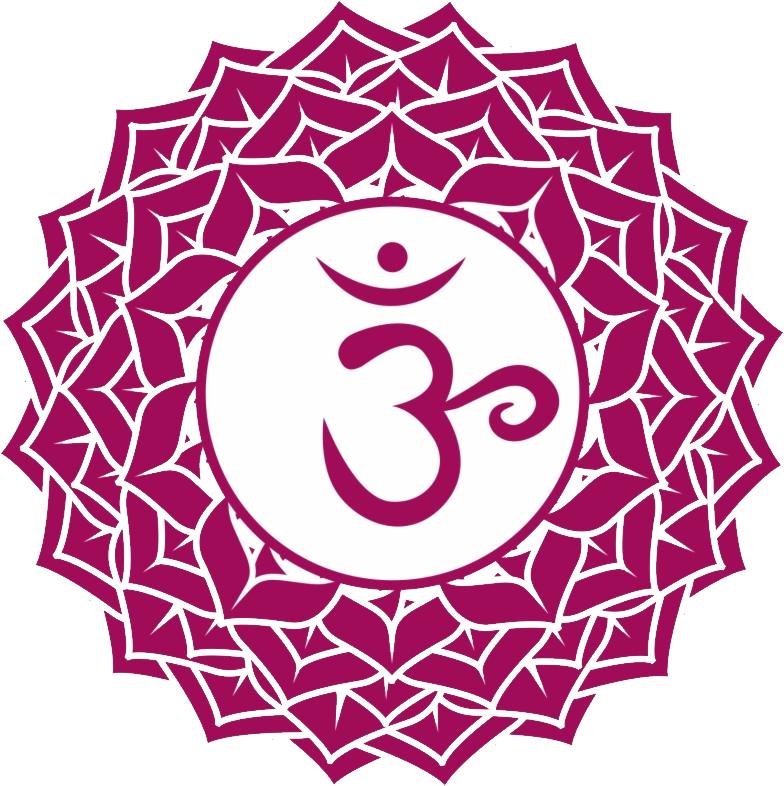
The circle represents the wholeness and completeness of our being, while the thousand petals symbolize the infinite possibilities and expressions of our consciousness. The OM symbol inside represents the primordial sound and vibration of the universe, which is the source and essence of all creation. The crown chakra’s seed sound is silence.
The crown chakra is responsible for our spiritual connection and enlightenment. When it is balanced, we feel connected to all that is, enlightened, and transcendent. When it is blocked, we may experience isolation, alienation, or spiritual crisis. Some of the benefits of crown chakra healing are:
- Increased spiritual connection and enlightenment
- Greater sense of peace and bliss
- Enhanced wisdom and understanding
- Better mental health
How to Use Chakra Symbols
Chakra symbols are powerful tools that can help us to balance and harmonize our energy system. Here are some ways to use them:
- Meditate on the chakra symbols. You can visualize them in their corresponding locations,
colors, and shapes, or use images, cards, or stickers as a focus point. You can also chant
or listen to their seed sounds to activate and align each chakra. - Wear or carry chakra symbols. You can wear jewelry, clothing, or accessories that have chakra symbols on them or carry stones, crystals, or charms that resonate with each chakra.
This can help you to attract and amplify the energy of each chakra throughout the day. - Decorate your space with chakra symbols. You can hang posters, paintings, or banners
that display chakra symbols in your home, office, or yoga studio. This can create a positive
and harmonious atmosphere that supports your well-being and spiritual growth.
Best Crystals for Chakra Healing
Crystals are natural minerals that have unique vibrational frequencies and healing properties. They can help us to balance and heal our chakras by absorbing, amplifying, or transmitting energy. Here are some of the best crystals for each chakra:
- Root Chakra: Red Jasper, Hematite, Smoky Quartz, Black Tourmaline, Garnet
- Sacral Chakra: Carnelian, Orange Calcite, Sunstone, Tiger’s Eye, Amber
- Solar Plexus Chakra: Citrine, Pyrite, Yellow Jasper, Lemon Quartz, Golden Topaz
- Heart Chakra: Rose Quartz, Green Aventurine, Malachite, Emerald, Jade
- Throat Chakra: Turquoise, Lapis Lazuli, Blue Lace Agate, Aquamarine, Sodalite
- Third Eye Chakra: Amethyst, Purple Fluorite, Labradorite, Moonstone, Iolite
- Crown Chakra: Clear Quartz, Selenite, Ametrine, Diamond, Herkimer Diamond
To use crystals for chakra healing, you can place them on your body in alignment with each chakra, hold them in your hands during meditation or prayer, wear them as jewelry or accessories, or place them around your space as decorations or grids.
FAQs in Relation to Chakra Symbols
What do the 7 chakras symbolize?
The seven chakras represent vital energy centers in our body, each linked to specific emotional and physical states.
What is the symbol of the chakra?
A lotus flower with a varying number of petals represents each unique chakra.
What religion is associated with chakras?
Hinduism and Buddhism are closely tied to the concept of chakras.
Which chakra belongs to which God?
In Hindu tradition, each main deity governs a different aspect reflected in corresponding individualized symbolism within each specific body’s own spirit.
Conclusion
Chakra symbols aren’t just mystical signs; they’re practical tools for balance and growth. They teach us about our inner strengths, from the grounded energy of Muladhara to Sahasrara’s divine connection.
Dive in, and you’ll discover stability through your root chakra. Embrace Svadhisthana to spark creativity. Stoke Manipura’s flames for confidence. An open Anahata invites love, while Vishuddha enhances communication. Trust Ajna for intuition and connect with Sahasrara for spiritual unity.
This ancient ladder within guides you toward harmony—body, mind, and spirit entwined. Chakra symbols are the key; use them well on this transformative climb.